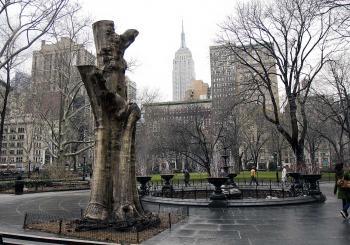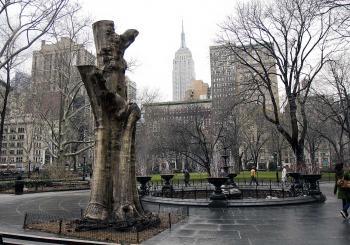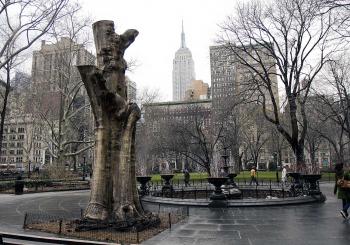NEW YORK—Talking to urban archivist Miriam Berman feels like reliving the rich and colorful history of Madison Square Park and taking a trip through one of New York City’s most memorable public outdoor spaces. Bernam, a long time local resident, is the author of “Madison Square: The Park and its Celebrated Landmarks.”
A graphic designer by profession, the Flatiron building was home to Berman’s office for nearly 10 years. She continued to maintain her graphic design business near the park for over 30 years.
Berman reminisced on how she first developed a curiosity and attraction for Madison Square Park. “It all started with my postcard collection in the late 1980s. Each postcard introduced me to a different building and the things that were around it,” said Berman.
Designated a public space in 1686 the park was named after James Madison, the fourth president of the United States. It was not until 1847 that the park formally opened. In 1870, the park was redesigned and became the center of one of the city’s most elite and fashionable neighborhoods.
The park became a place for public gatherings. “This is the place where people came to see election night results,” says Berman.
Despite its prominence, by the 1990s, the park was in a dilapidated and neglected state. Inadequate lighting and unclear signs rendered the park unsafe at night although it was still frequented by office workers on weekdays. With cracked asphalt, and eroded lawns that had become dry and dusty patches, the park became a haven for drug addicts and the homeless.
Eventually sufficient funds were raised for the renovation, which endeavored to refurbish the park to its original 19th century design. The restored park boasts lush green lawns, flowering plants, benches, new paving on pathways, a fountain, a reflecting pool, and decorative lighting.
The beautified park triggered new residential projects in the surrounding areas leading to a new generation of young park users. Nestled in the heart of a thriving business area, today Madison Square Park continues to draw residents and visitors from all walks of life to linger and savor the beauty of urban park life.
Madison Square Park was a fountain of inspiration and a magnet for writers, artists, architects, and photographers. Author William Sydney Porter, writing under the pseudonym Oliver Henry, wrote several short stories about life in the park, including “A Madison Square Arabian Night,” “The Sparrows in Madison Square,” and other short stories.
Architect Stanford White designed two buildings near the park, the second Madison Square Gardens building and the Madison Square Presbyterian Church, as well as the exedra base for the Admiral David Glasgow Farragut Monument.
The park was also one of artist John Sloan’s favorite sites. Aptly described as ‘historian of Madison Square,’ by one of his students, one of Sloan’s oil on canvas paintings known as “Dust Storm, Fifth Avenue,” was completed in 1906. Likewise, photographers Edward Stieglitz, Alfred Steichen, Paul Strand, and others have immortalized the park and the Flatiron building.
The rich history of the park and its surrounding buildings are kept alive every Sunday. The Flatiron 23rd Street partnership sponsors free walking tours, with three experienced tour guides who take turns each Sunday to tell the story of Madison Square Park.
Though it might seem logical to look for Madison Square Gardens in Madison Square Park, the famed performance hall and sports arena has moved on. It is “the one that walked away with the name,” said Berman.
There have been four Madison Square Gardens, according to Berman. The original opened in 1879 and was located at Madison Avenue and 26th Street. The second was built at the same location in 1890 and closed in 1925. The third was located at Eighth Avenue and 50th Street. The fourth and current Madison Square Gardens is at 33rd Street, between Seventh and Eighth avenues, and sits on the top of Penn Station.
Besides the pin oak, there are two English elm trees that have graced the park for nearly 200 years. The first tree is on the north side, to the right of the Admiral David Glasgow Farragut Monument. What is left of the second tree, only its stump, is south of the fountain, and near the Shake Shack, a roadside burger stand with a constant line of hungry and loyal patrons. The tree stump is kept in the park to mark its significance.
The park was the home of the first public Christmas tree, installed in 1912. “This is the site of the very first public tree in the United States,” reflected Berman. “It’s very poignant. That means it outdates the tree at Rockefeller Center and wherever else you’ve seen a public Christmas tree.”
Next: MONUMENTS IN THE PARK
A graphic designer by profession, the Flatiron building was home to Berman’s office for nearly 10 years. She continued to maintain her graphic design business near the park for over 30 years.
Berman reminisced on how she first developed a curiosity and attraction for Madison Square Park. “It all started with my postcard collection in the late 1980s. Each postcard introduced me to a different building and the things that were around it,” said Berman.
Designated a public space in 1686 the park was named after James Madison, the fourth president of the United States. It was not until 1847 that the park formally opened. In 1870, the park was redesigned and became the center of one of the city’s most elite and fashionable neighborhoods.
The park became a place for public gatherings. “This is the place where people came to see election night results,” says Berman.
Despite its prominence, by the 1990s, the park was in a dilapidated and neglected state. Inadequate lighting and unclear signs rendered the park unsafe at night although it was still frequented by office workers on weekdays. With cracked asphalt, and eroded lawns that had become dry and dusty patches, the park became a haven for drug addicts and the homeless.
Eventually sufficient funds were raised for the renovation, which endeavored to refurbish the park to its original 19th century design. The restored park boasts lush green lawns, flowering plants, benches, new paving on pathways, a fountain, a reflecting pool, and decorative lighting.
The beautified park triggered new residential projects in the surrounding areas leading to a new generation of young park users. Nestled in the heart of a thriving business area, today Madison Square Park continues to draw residents and visitors from all walks of life to linger and savor the beauty of urban park life.
SOURCE OF INSPIRATION
Madison Square Park was a fountain of inspiration and a magnet for writers, artists, architects, and photographers. Author William Sydney Porter, writing under the pseudonym Oliver Henry, wrote several short stories about life in the park, including “A Madison Square Arabian Night,” “The Sparrows in Madison Square,” and other short stories.
Architect Stanford White designed two buildings near the park, the second Madison Square Gardens building and the Madison Square Presbyterian Church, as well as the exedra base for the Admiral David Glasgow Farragut Monument.
The park was also one of artist John Sloan’s favorite sites. Aptly described as ‘historian of Madison Square,’ by one of his students, one of Sloan’s oil on canvas paintings known as “Dust Storm, Fifth Avenue,” was completed in 1906. Likewise, photographers Edward Stieglitz, Alfred Steichen, Paul Strand, and others have immortalized the park and the Flatiron building.
The rich history of the park and its surrounding buildings are kept alive every Sunday. The Flatiron 23rd Street partnership sponsors free walking tours, with three experienced tour guides who take turns each Sunday to tell the story of Madison Square Park.
Though it might seem logical to look for Madison Square Gardens in Madison Square Park, the famed performance hall and sports arena has moved on. It is “the one that walked away with the name,” said Berman.
There have been four Madison Square Gardens, according to Berman. The original opened in 1879 and was located at Madison Avenue and 26th Street. The second was built at the same location in 1890 and closed in 1925. The third was located at Eighth Avenue and 50th Street. The fourth and current Madison Square Gardens is at 33rd Street, between Seventh and Eighth avenues, and sits on the top of Penn Station.
TREES IN THE PARK
The most prominent tree is the pin oak from President Madison’s Virginia estate. The sapling was presented to the park in 1936 to celebrate the centennial opening of Madison Avenue, as stated in Berman’s book. Apart from the presence of this tree, there is no monument in the park to commemorate the man the park is named after.Besides the pin oak, there are two English elm trees that have graced the park for nearly 200 years. The first tree is on the north side, to the right of the Admiral David Glasgow Farragut Monument. What is left of the second tree, only its stump, is south of the fountain, and near the Shake Shack, a roadside burger stand with a constant line of hungry and loyal patrons. The tree stump is kept in the park to mark its significance.
The park was the home of the first public Christmas tree, installed in 1912. “This is the site of the very first public tree in the United States,” reflected Berman. “It’s very poignant. That means it outdates the tree at Rockefeller Center and wherever else you’ve seen a public Christmas tree.”
Next: MONUMENTS IN THE PARK






